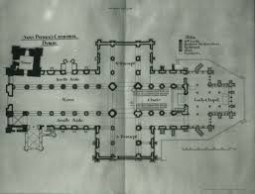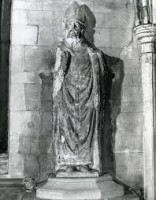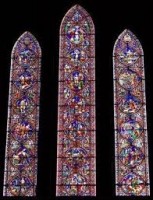Last week was National Heritage Week and I thought it be a good idea to go to some of the events that are being held in our own Dublin 8. St Patrick’s Cathedral is a very good place to start, as it is right on the border of Dublin 8. As part of Heritage Week the Cathedral is giving free tours. It was an amazing trip down memory lane. It is a place of worship of course, but once served as a courtroom, university and even horse stables. The legend of its name refers to a well in the vicinity where the Cathedral was built, which was allegedly used by St Patrick to baptize pagans. Six Celtic grave-stone slabs dating back to the eighth century were found in 1901 near the Cathedral, one of them on the well itself.
The Cathedral itself is medieval. It’s gothic in design and was built in 1220-1259 by the Archbishop Luke who was responsible for the construction. Luke built in the shape of a cruciform, with the main body of the cross called the Nave, the top called the Choir and the arms called the Transepts. The building is made from limestone and stone from Bristol. The original church was a wooden church and would not have survived the fires and storms the present Cathedral faced in 1316 and 1362, so thanks be to St Patrick for giving the church clergy the blessing of progressing in the building trade. When you enter by the steps that lead you down into the Cathedral, you will find that it is below the present floor level of the city, even though this part of the floor, covered in beautiful tiles, was lifted to the same level of the Choir, it is still lower than present Dublin. The tiles has an interesting story, some of them are turned the wrong way around to break the pattern and to make it look imperfect. The reason this was done, is to remind people of worship that no-one is perfect. 
The Cathedral now stands on an island with the river Poddle running underneath it. There is no crypt underneath the Cathedral, as you would find at Christ Church, but there are burials and graves underneath the Cathedral, with one exception, that of a military commander called Lord Lisburn (the grandson of a former Dean) who was buried inside of the Choir of the Cathedral. Above the door that leads into the Choir area, there is a cannonball hanging from the wall next to the entrance door where he was buried. It was taken from the dead man’s body when he was struck by it during the siege of Limerick. His family donated the cannonball to the Cathedral with a boars head’s skull that can be seen just above the cannonball; the boar being the Lisburn family’s totem animal.
The Choir area was not only used for the choir but was also the place where the Knights of the Order of St Patrick, an organisation set up in the 18th Century to reward the loyalty to the crown, used to be seated at special services. Today you can see the royal seats with a flag for each Knight, and his sword and helmet, hanging above each chair. Ceremonies where new knights were baptized into the order took place in the Cathedral and in later years in Dublin Castle.
The Cathedral being gothic and medieval, gives one the sense of a darker time in history, when war seemed more prevalent. The building is adorned in the vestiges of British wars over the centuries. The Irish of course fought in many of these wars such as the Boer War, the Crimean War, the First World War and others.
The statute of St Patrick is situated in the southern transept of the Cathedral and has a very quirky story. It is a statute that comprises of three different statutes put together as one, one being the head of a bishop. The three statues were found on the grounds of the Cathedral. The statue itself has no neck. It has become a representation of the saint and is depicted in pictures, but of course there is no prove or evidence that any part of this Frankenstein model even looked like the monument.
The Cathedral has seen many Deans serving, one of the most famous of course, is satirist Jonathan Swift (1667-1745). Swift wrote many books in his life time “Gulliver’s Travels”, “A Modest Proposal” and “A Tale of a Tub” to mention only a few.
There are two death masks of Swift, a cast of his skull and books written by him on display. The death masks were made from wax moulds and then plaster casted after pouring the wax over the corpse. Swift’s own satirical personality would not have had a problem with the idea of boiling wax poured over his corpse, as in “A Modest Proposal” he suggests that the impoverished Irish could solve their economical troubles by selling their children as food to rich gentlemen and ladies. He was known as a madman towards the end of his life and wrote his own epitaph before he died. It is up on the Cathedral wall and reads:
Here is laid the Body of Jonathan Swift, Doctor of Sacred Theology, Dean of this Cathedral Church, where fierce Indignation can no longer injure the Heart. Go forth, Voyager, and copy, if you can, this vigorous (to the best of his ability) Champion of Liberty.
He died on the 19th Day of the Month of October,
A.D. 1745, in the 78th Year of his Age
Something else that stood out for me as I think back on the walk I took through the Cathedral with our very well spoken tour guide, was the famous Door of Reconciliation. The story follows two families, the Fitzgerald’s of Kildare and the Butlers of Ormonde who were forever feuding across the city walls. The disagreement was over the position of Lord Deputy, which both family vied for, the fight turned bloody on the streets of Dublin on one occasion. A retreating Butler family escaped into the Cathedral and barricaded the door. After a siege, peace was struck when Gerald Fitzgerald cut a hole in the door and offered his hand in peace through the door. The move could have landed with Gerald losing a hand but the Butlers made peace. Unfortunately, the peace was short lived and the families were back fighting within two days. The saying “To chance your arm or don’t chance your arm” originated from this little tale. Some tourists in times past use the tour to make peace by shaking hands through it, with the caveat that it will only last two days!
The Cathedral is the host of over 200 monuments and two of these are the tombs belonging to the families Jones and Boyle. The Boyles monument being the bigger one is now located in the west end of the Cathedral and has been the root of controversy since it was first erected by Richard Boyle in 1632. It was originally placed in east end of the Choir, but caused great offense to some Lords and Archbishops and was then moved to the west end in 1863. Swift was responsible for the repair work on the vaults, but for some mysterious reason allegorical figures, coronets and a few junior family members went missing when it was moved from its original place. The Boyle family is famous for Robert Boyle – the famous Irish scientist accredited as the Father of Chemistry.
The Guinness family donated approximately £150,000 on the restoration of the building when the Cathedral. A glass stained window in the southern transept was made in honour of the Lady Guinness. In those years, Guinness was not as big a brewery as it is today and sold the porter in smaller amounts, but something quite cute and funny was added to the window at the bottom, a scripture from Matthew 25:35 reading: “I was thirsty, and ye gave me drink”.
Finally when the tour comes to an end we were taken to the west end of the building where three windows can be seen. The three stained glass windows tells the story of St Patrick and on each window there is four or more medallions with a part of the story painted on it, this was done for those who couldn’t read, but could translate stories in picture forms. Not many people were literate back then and this would have been one of the common ways to tell stories. The windows have to be read starting from the bottom left on the left window before moving over to the far right window, also starting at the bottom and then finally reading the centre window from the bottom upwards. Like a predecessor to the comic!
This is a very enjoyable tour and I recommend you try it out.










